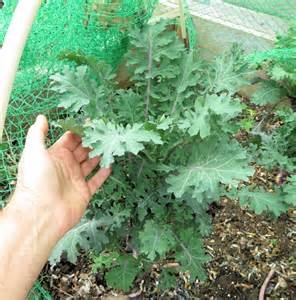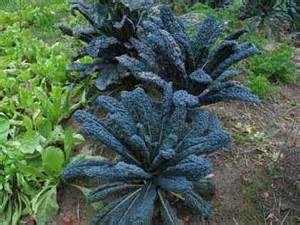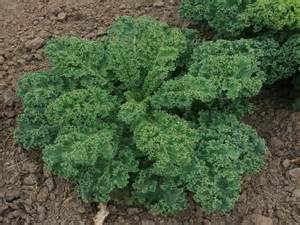
When the Napa County Master Gardeners decided to field-test kale last year, I decided it was finally time try some. Kale comes in many shapes, sizes, colors and textures, and catalogs offer a huge selection of seed.
When you growing plants from seed, you have a wider selection than what the nurseries or “big-box” stores typically carry. What's more, some of the vegetable varieties that the nursery trade grows are chosen for their ability to withstand handling, transport and display, not necessarily for their taste.
Kale is a fast-growing source of greens during our cool season. Most kales are extremely winter hardy and become sweeter with frost. Harvest can continue through winter in Napa County. Kale can be eaten raw in salads or cooked for a side dish, pasta or soup. Many of the colored varieties, including some that we grew in our trial, make attractive ornamental plants.
Harvest leaves from the outside so that the plant can continue to push new leaves from the center. As the plants mature and you remove more outside leaves, the plants can start to look like miniature trees with foliage on top of a long stem.
The field-test committee grew three varieties of kale last fall, all strikingly different.We evaluated each type for productivity, vigor and health, and for flavor and texture, both cooked and uncooked. All three types had high germination rates, ranging from 87 percent to 91 percent.
One variety we grew was 'Nero di Toscana,' a popular type often seen in grocery stores. This Italian heirloom has strap-like leaves about 3 inches and 10 to 18 inches long. It is familiarly known as dinosaur kale because of its crinkly texture.
We also tested 'Red Ursa' kale, a Russian variety. It grows into a gorgeous plant with a fountain of big frilly leaves with purple veins and stems. 'Dwarf Blue Curled Scotch' was our third selection. It is a low-growing, spreading, early kale with tightly curled, blue-green leaves, beautiful enough to be grown solely as an ornamental. The other two varieties rated higher in most categories, but no single variety was the unanimous favorite.
Some field testers found 'Blue Curled Scotch' harder to clean because of its curly leaves, and chewier and stronger in flavor. Others thought 'Red Ursa' was the prettiest and easy to use in cooking and salads. 'Nero di Toscana' generated the most enthusiastic comments and was voted most likely to be planted again. Master Gardeners liked its flavor and found it more tender and productive than the others, although it suffered more damage from cabbage larvae. Row covers helped keep bird damage to a minimum. Other pests that can damage kale include slugs and snails, cutworms, flea beetles, cabbage-root maggots and aphids.
A majority of testers said that they would grow kale again. There was a lot of enthusiasm and recipe-swapping at our meetings, with kale featured in everything from soup to chips to smoothies. Many especially enjoyed kale raw in salads. Testers appreciated that the plants produced for a long time if they harvested only outside leaves.
You can plant kale seed directly in the ground from the third week of July until mid-August. Protect young seedlings from insect damage by using row cover. You can also start kale indoors and set out transplants from the third week of August through mid-September.
Kale likes full sun but can benefit from light shade during hot weather. It prefers consistent moisture but can tolerate drought, although the flavor will suffer. Cool weather slows the damage from pests, making kale easier to grow. To minimize disease, avoid planting kale or other cabbage-family crops in the same location more than once every three to four years. Seed remains viable for up to four years.
Garden Tour: The Master Gardeners of Napa County invite you to attend their sixth garden tour, “Down the Garden Path,” on Sunday, September 13. On this self-guided educational tour, you will see seven gardens owned by Master Gardeners in and around the City of Napa. These gardens illustrate how Napa County Master Gardeners use University of California research-based horticultural information to develop and maintain their own gardens. Tickets: $30 advance / $35 day of event. Purchase tickets here - http://bit.ly/1fqLJZe. Or you can purchase tickets at the Master Gardener office (address below). For more information, call 707-253-4143.
Workshop: Napa County Master Gardeners will hold a workshop on “Home Vineyard: Part 2” on Saturday, August 15, from 9:30 a.m. to 2 p.m. (with a 30-minute lunch break. Learn what to do and what to look for and how to plan for harvest and crush in the vineyard, testing the must, managing the vines after crush, and preparing for winter and the next growing season. Master Gardeners with home vineyards will present this workshop, and answer your questions. Please bring a sack lunch, comfortable clothes and shoes for walking through the experimental vineyard. Location is the University of California Oakville Experimental Station, 1380 Oakville Grade Road, Napa. Online registration (credit card only)Mail-in registration (cash or check only)
Master Gardeners are volunteers who help the University of California reach the gardening public with home gardening information. Napa County Master Gardeners ( http://ucanr.org/ucmgnapa/) are available to answer gardening questions in person or by phone, Monday, Wednesday and Friday, 9 a.m. to Noon, at the U. C. Cooperative Extension office, 1710 Soscol Avenue, Suite 4, Napa, 707-253-4143, or from outside City of Napa toll-free at 877-279-3065. Or e-mail your garden questions by following the guidelines on our web site. Click on Napa, then on Have Garden Questions? Find us on Facebook under UC Master Gardeners of Napa County.
Attached Images:

